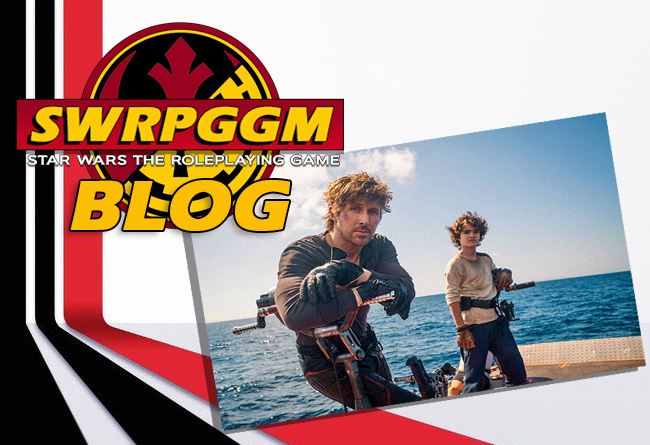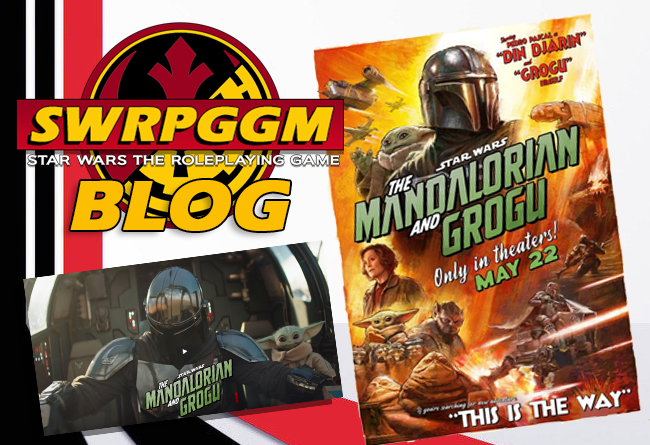The most iconic armor in all of Star Wars has been the white armor of the standard Stormtrooper. The Imperial Stormtrooper first appeared in Star Wars A New Hope and the style would remain in the lexicon of the Star Wars Universe from that point on. Lore wise the armor actually comes from the previous generation of Republic Trooper, the Clone Troopers. Designed to go to war for the Republic if ever called upon, the Clones were the best trained and equipped military force of it’s age. They began the move to fully armored infantry that became a staple of the Empire. In this article we will look at the evolution of the standard Stormtrooper from their origins and armor to the Stormtroopers of the First Order / Final Order Sith.
The Clone Troopers
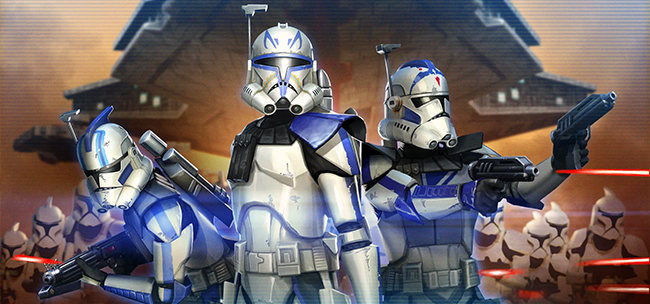
Clone troopers, also known as Republic troopers, Republic troops, Republic soldiers, and nicknamed the “Boys in White,” were highly trained soldiers in the Grand Army of the Republic. Representing the future of galactic warfare, clones were designed to be far superior to battle droids. During the last years of the Galactic Republic, clones formed the backbone of the Republic Military that waged war against the droid armies of the Confederacy of Independent Systems. The Clone Wars was named after the Republic’s clone army, which became symbolic of the conflict that had spread throughout the galaxy after a millennium of peace.
Clone troopers were grown on the planet Kamino at the request of Jedi Master Sifo-Dyas, who commissioned the Kaminoans to build an army for the Republic, although some clones were secretly grown on Coruscant and became the shock troopers in the Coruscant Guard. After Sifo Dyas’ death, the project was taken over by the Sith. Clones were modeled on a human template, the bounty hunter Jango Fett, although their genetic structure was modified to make them less independent and more docile than their progenitor. They were also designed to age at twice the rate of natural humans, accelerating their growth and making them ready for combat in a decade’s time. As the Separatist Crisis gave way to open war, the Galactic Senate empowered Supreme Chancellor Sheev Palpatine to call the clone troopers into action, leading to their debut on the battlefield of Geonosis. For three years, clones fought the Separatist droids on all fronts across the galaxy. They were loyal to their Jedi Generals and the Supreme Chancellor; though some clones questioned their service, leading to isolated cases of desertion and treason, most were proud to serve the Republic as it was the only life they had ever known.
Galactic history was forever changed by a hidden behavioral modification biochip implanted in every clone, which was part of the Sith’s plot to destroy the Jedi. Chancellor Palpatine, discovered by the Jedi to be the Sith Lord Darth Sidious, as well as the reason behind the Clone Wars, branded the Jedi as the enemies of the state and issued Order 66, with the latter being a calling for the annihilation of the Jedi Order. All across the galaxy, the clones turned against their generals, slaughtering them and storming the Jedi Temple on Coruscant under the stewardship of the Sith Lord Darth Vader. Sidious subsequently assumed absolute power as the self-proclaimed Emperor of the Galactic Empire. Clones initially served as Imperial stormtroopers in the New Order, but were soon replaced by human recruits and conscripts. Their armor, weapons, and training inspired generations of white-armored warriors, especially the First Order stormtroopers who were also trained from early childhood to become super-soldiers.
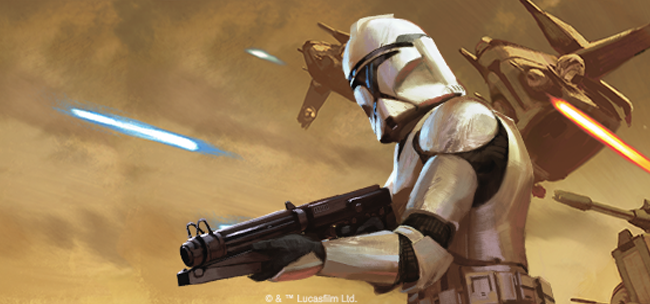
Phase I Clone Armor
Created by Kaminoan armorsmiths for the clone troopers of the Galactic Republic, the Phase I armor consisted of twenty form-fitting plates of lightweight plastoid-alloy composite. Those plates were sealed to a black temperature control bodysuit via magnatomic gription panels. The bodysuit was also pressurized, offering temporary protection against the vacuum of space, and the body glove protected the clone from the extreme cold and heat. The armor’s design was reminiscent of the Mandalorian armor, including the helmet with a distinctive T-shaped visor. Despite its advantages, the Phase I armor proved uncomfortable for the troopers to fit in, which was due to the Kaminoans’ unfamiliarity with human ergonomics.
Inside the Phase I helmet, a clone trooper had a life support system, a tracking device for monitoring troop movements, and a display screen, which was built into the helmet’s viewplate. The helmet also contained a comlink, and a comlink antenna was located in the helmet’s crest. A clone could also have attachments to their helmets, such as macrobinoculars, a rangefinder, or a visor.
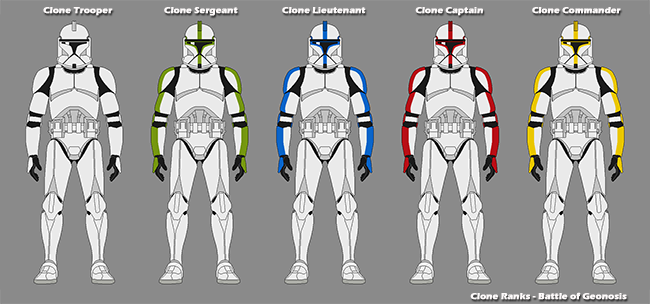
Phase II Clone Armor
Phase II clone trooper armor was manufactured by Kaminoan armorsmiths. More advanced than the Phase I clone trooper armor, Phase II armor was capable of supporting more specialized equipment. It was, therefore, more expensive to produce, costing 3,000 credits per suit whereas Phase I cost 2,000 credits. Unlike Phase I, Phase II did not feature an internal life support system, necessitating the use of an external respirator in the absence of breathable atmosphere. As such, Phase II helmets were featured an advanced filtration system, and were also designed to be more comfortable to wear than Phase I helmets.
Like its predecessor, Phase II was a set of form-fitting white plastoid plates over a black body glove. In addition to providing its wearer with better vision, the armor plates were lighter and stronger than that of Phase I. While Phase II was capable of withstanding impacts, pressure, heat and acrid vapors, the armor was vulnerable to a direct hit from a laser blast.
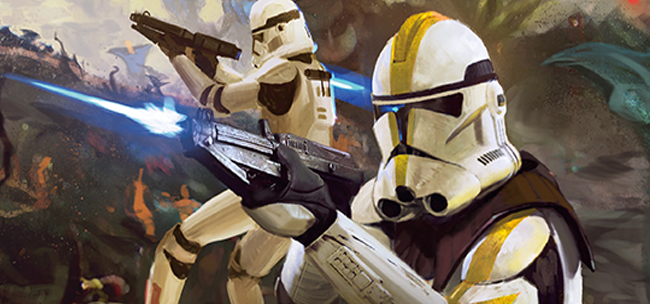
Imperial Stormtrooper
The Galactic Empire, declared as the First Galactic Empire, commonly referred to as simply the Empire, and remembered as the Old Empire, was the fascist galactic government that replaced the Galactic Republic in the aftermath of the Clone Wars and ushered galactic civilization into a new age.
The Empire, also known as the New Order, was founded and ruled by Galactic Emperor Sheev Palpatine, who was secretly a Dark Lord of the Sith called Darth Sidious. The new regime rose to power with a groundswell of populist support, promising peace and stability from the destructive Clone Wars and capitalizing on anti-Jedi and anti-droid sentiment and human-ethnocentrism. The subsequent Age of the Empire would last only two decades in contrast to the centuries of the Republic Era, but not before the Jedi Order was systematically purged and almost eradicated, and the galaxy largely conquered and oppressed.

The Empire stood virtually unchallenged until numerous insurgent cells united to initiate the Galactic Civil War, with the growing rebellion winning its first major victory over Mustafar in 4 BBY. These rebel cells formed the Alliance to Restore the Republic in 2 BBY, and the Rebel Alliance itself achieved its first major victory with the theft of the Death Star plans on Scarif which, in turn, led to the destruction of the Death Star at the Battle of Yavin in 0 BBY. The following years saw initial Alliance successes until a major Imperial victory on Hoth in 3 ABY, but the Empire suffered a devastating defeat one year later at the Battle of Endor. During the battle, Emperor Palpatine was slain at the hands of his Sith apprentice, Darth Vader, who also died shortly after turning against his Sith Master.
With the Emperor dead and the Sith Lords extinct, factionalism overcame the Empire as it fractured into fiefdoms led by Moffs, admirals, and generals, many of whom ignored Grand Vizier Mas Amedda’s authority at the capital and became warlords. Loyalist forces of the Imperial Navy came to be publicly led by Grand Admiral Rae Sloane and covertly ruled by Fleet Admiral Gallius Rax and his Shadow Council. Ultimately, Rax seized control over their forces, removing Sloane from power and becoming Emperor-in-effect through his new position as Counselor to the Empire. Under Rax’s command, the Empire made its final stand at the Battle of Jakku in 5 ABY, ultimately losing to the New Republic. While several Imperial holdouts continued to resist, the Empire formally capitulated to the New Republic with the signing of the Galactic Concordance.
During the New Republic Era, war reparations and disarmament treaties reduced the once mighty Empire to a mere rump state, with one remnant state forced to remain within predetermined borders of the Core and Inner Rim, agreeing to punitive stipulations, while another remnant state remained locked in the Cold War with the New Republic. The former central government on Coruscant was reorganized into a provincial administration overseen by New Republic observers. However, the Imperial legacy endured, for in the Unknown Regions, former Imperial officers, nobles, technologists, and warlords that fled known space following the New Republic’s rise regrouped and plotted their return to power; their movement eventually became the First Order.
Imperial Stormtrooper Armor
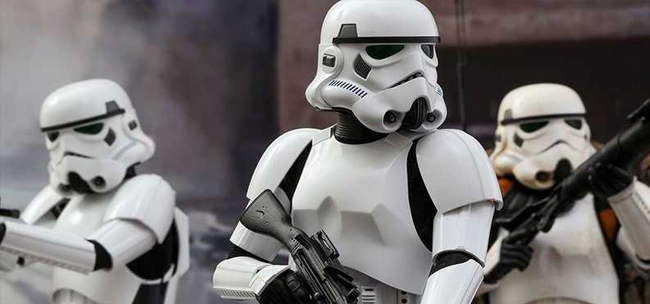
Developed by the Imperial Department of Military Research, stormtrooper armor was the standard issue armor of the Imperial Army’s Stormtrooper Corps, and was manufactured on planets such as Gilvaanen. It was introduced sometime after the conclusion of the Clone Wars, and was intended to replace the Phase II clone trooper armor. It was made up of 18 individual, overlapping plastoid composite plates and synth-leather boots which allowed for mobility, while also dispersing energy, protecting the wearer from glancing blaster bolts. A reinforced alloy plate ridge assisted the user’s upper thigh, and a sniper position knee protector plate over a wearer’s left knee helped improve accuracy when crouching. While most armor was fitted for humans, other forms were manufactured to fit other body types. A soft click would inform the wearer of whether or not they had correctly attached the armor.
Its reinforced combat helmet featured an integrated comlink, audio pick-up, two artificial air-supply hoses, and a broadband communications antenna powered by a single power cell. The helmet, affectionately known as “buckets” by Imperials but derisively known by that name by rebels, featured built-in filtration systems that extracted breathable atmosphere from polluted environments. The helmet’s visual processor assisted the wearer in seeing in darkness, glare, and smoke, though it limited the wearer’s field of vision. When firing a blaster, the helmet’s visor polarized against the glare. A built-in heads-up display also provided targeting diagnostics, power levels and environmental readings at the corner of the wearer’s eyesight, and one could access data on various military subjects and civilian organizations on the helmets display. In addition, motion sensors alerted the wearer to any enemy the soldier might have missed. Seeking to discourage nonessential chatter, which was strictly off-limits while on-duty, stormtrooper helmets recorded everything that was said by the user, sending it to monitors to review after downloading the data off of the armor’s memory.
Stormtrooper armor was capable of protecting its wearer in extreme environments, including deserts, forest, icy wastelands, and limited exposure to the vacuum of space. The armor’s torso plating featured environmental controls on its midsection, its black body glove was vacuum-sealed and made of a smart material that could adjust to the wearers body heat and external temperature. Though a rebreather pack was required for extended use in environments that lacked a breathable atmosphere or to filter potent toxins. Troops in the field were allowed additional ammunition and comprehensive survival equipment, with backpacks that could feature field communicator sets, mortar launchers, and blaster components. It was a punishable offense to utilize the armor’s internal cooling options in noncritical situations due to its power drain, however many Imperial cadets still attempted to do so. Stormtroopers were also expected to remain in uniform at all times, with the rule considered essential for maintaining the public trust and representing the Empire in a positive, professional manner. By wearing one’s armor, one represented the Empire, not the individual.
Utility belts were equipped with a variety of features including a compact toolkit, power packs, energy rations, and a holster for an E-11 blaster rifle. The belts may have also featured a backup C1 personal comlink, macro binoculars, and a grappling hook. One BlasTech N-20 Baradium-core thermal detonator was given to each trooper, and was placed on the back of their utility belt. The controls to the detonator were not labeled, to prevent enemy troops from using them. While detonators were not usually used within ships or bases, troopers carried a full complement of such field gear to be prepared for any situation.
Higher ranks were signified with a color coded pauldron worn over the right shoulder. The rank of commander was represented with an orange pauldron, though one soldier who served under the Grand Inquisitor had his colored red. Black identified enlisted soldiers. Several black pauldroned stormtroopers accompanied Grand Moff Wilhuff Tarkin to the planet Lothal, and later came aboard his flagship, the Sovereign, to serve as reinforcements when it was infiltrated by a band of rebels. White pauldrons represented the rank of sergeant. Blue pauldrons were used to identify stormtrooper snipers.
Despite small aesthetic variations in stormtrooper armor during the Age of the Empire, the changes were not large enough to denote a new phase of armor like the previous Galactic Republic’s phase I clone trooper armor and phase II clone trooper armor. As a result, Imperial armor changes were largely due to production purposes.

First Order Stormtrooper
First Order stormtroopers were the infantry soldiers of the First Order that were deployed from within the Unknown Regions. As the latest evolution of one of galactic history’s most distinctive symbols of military might, the First Order’s infantry units were outfitted with stark white armor derived from that worn by the Galactic Republic’s clone troopers and the Galactic Empire’s identically named elite shock troops. To ensure absolute loyalty and conformity, First Order troopers were identified by alphanumeric designations instead of individual names and programmed from birth through regular exposure to state-controlled propaganda. Ultimately, members of this new generation of stormtroopers were trained to serve one purpose—conquering the galaxy in the name of the First Order.
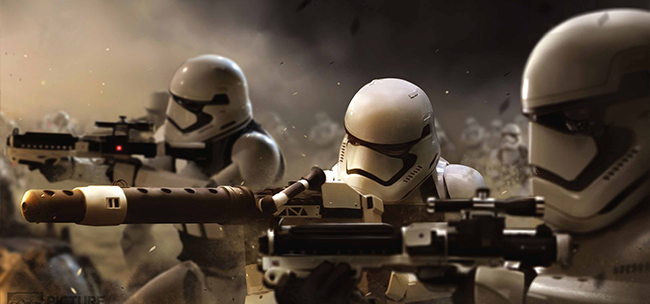
The First Order Stormtrooper Corps was formed during the New Republic Era, following the collapse of its Imperial-era predecessor in the aftermath of the Galactic Civil War. Though the Galactic Concordance banned the mobilization of stormtroopers, the First Order secretly began its own stormtrooper program under the supervision of General Brendol Hux and Captain Cardinal, and later General Armitage Hux and Captain Phasma. Throughout its time, the program was centered on training human conscripts from early childhood. During the Cold War between the First Order and the New Republic, stormtroopers were presented as a territorial protection force. After the destruction of the New Republic capital, their true nature as the First Order’s invasion army was revealed, leading to open war against the Resistance.
Having conquered large swathes of territory, stormtroopers became the enforcers of a new galactic order ruled by Supreme Leader Kylo Ren—the dark warrior who succeeded Snoke as absolute ruler of the First Order. By the final days of the conflict, stormtroopers were supplemented by the red armored Sith troopers, a secret army developed on the hidden world of Exegol by the Sith Eternal cult. Despite their combined power, the newly-formed Final Order was ultimately defeated by Resistance forces and their allies at the Battle of Exegol, after which the First Order military faced a series of uprisings across the galaxy.
First Order Stormtooper Armor
First Order stormtroopers wore stark white-colored armor, the design of which drew inspiration from that of the foregone Republic clone troopers of the Clone Wars and the Imperial stormtroopers of the Galactic Civil War. Like its predecessors, the armor was worn over a black body glove. The First Order, during its conflict with the Resistance and its supporting government, the New Republic, sought to have the recognizable and once-feared stormtroopers once again lead the charge against the former enemies of the Galactic Empire.
The design of past stormtrooper armor was improved upon, adding at least greater flexibility through an updated joint design. Individual sets of armor were linked to First Order trackers. One stormtrooper captain, Phasma, wore her own distinctive stormtrooper armor polished in chromium as a representation of power. Other specialized stormtroopers, such as flametroopers and snowtroopers, wore a variant of the First Order stormtrooper armor representing their specializations. To denote rank, commanding stormtroopers wore color-coded pauldron armor plates.
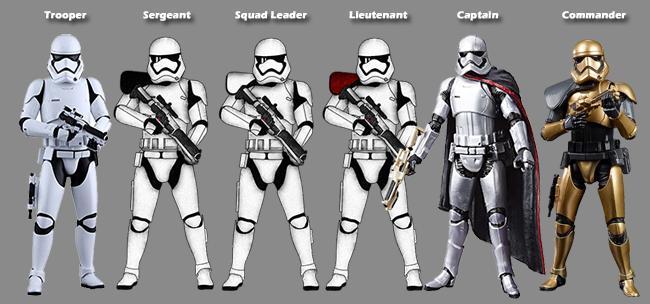
The stormtrooper helmets had a glossy betaplast finish, which required constant cleaning. They were also equipped with a smoke filtration system and an external tank hook-up, although the helmets could not filter toxins. Aside from providing standard protection for the wearer’s head, the stormtrooper helmet had both communication and targeting systems for the foot soldiers, although quadnoculars were required for any enhanced imaging. Also within the helmet, was a near-constant stream of data projected across the lenses—telemetry, firing solutions, atmospheric conditions, everything up to and including the ammo count for the blaster rifle—individual ID tags would pop up whenever one looked directly at another trooper, the in-suit computer able to read friendly identifications.
The same stream of data could also determine the exact distance between the wearer and for instance, their allies, FN-2187 once could see that Slip was exactly 29.3 meters back. Or, the exact distance between the wearer and the objective. The helmets contained polarized lenses and night vision, but lacked advanced imaging gear in order to keep the helmet’s weight down.
The armor was strong enough to withstand the strength of a Wookiee, according to Captain Phasma, the commanding officer of the First Order’s stormtrooper legions. Archex derived a sense of belonging and purpose from the armor that he wore as a stormtrooper, prior to deserting the First Order military.
Sith Troopers
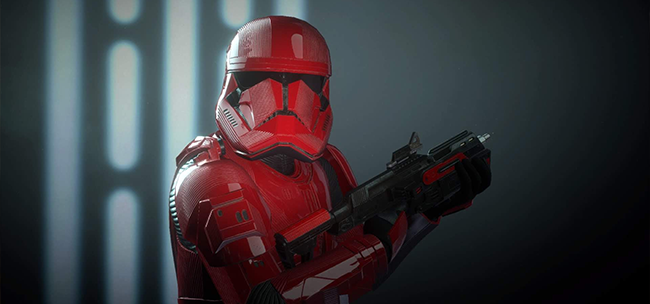
Sith Troopers, were elite soldiers in the Sith Eternal army that was created on the planet Exegol during the New Republic Era. The army comprised the children of the Sith Eternal, a Sith cult that revered the dark side of the Force. While Sith troopers were named after the Jedi Order’s ancient rival, the Sith Order, they were not Force-sensitive like their namesake. Nevertheless, they shared the Sith cultists’ devotion to the Sith religion. Taking inspiration from the Sith legacy that was built on fear and death, the armor worn by Sith troopers was red like Sith lightsaber blades and the Emperor’s Royal Guard. They were the culmination of the Contingency created by Darth Sidious—Dark Lord of the Sith and Galactic Emperor—whose goal was to return the galaxy to a dark age of a thousand years past, under the eternal reign of a new Sith Empire.
Sith troopers followed in the tradition of armored infantry units, one of the most enduring symbols of military might in galactic history. This heritage began with the white-armored clone trooper legions that fought in the Clone Wars, representing hope to the citizens of the Galactic Republic. The Galactic Empire and the First Order appropriated the clone army’s legacy, in turn, altering it into a symbol of fascist rule. Neither Imperial stormtroopers nor First Order stormtroopers were clones, but both armies were conditioned for absolute loyalty. Building on the success of methods used by Kaminoan scientists, the Sith Eternal succeeded in suppressing the individuality of the Sith troopers. As a result, Sith troopers were even more loyal and obedient than the Empire’s recruits and the First Order’s child conscripts. While all Sith troopers were dedicated to the Sith cause, only the best in their ranks served as Sovereign Protectors, a cohort of royal guards stationed in the Sith Citadel and the amphitheater housing the Throne of the Sith.
The Sith troopers were awaiting deployment during the final days of the First Order/Resistance War. Darth Sidious, having returned long after his demise at Endor, set out to reconquer the galaxy through the Final Order—a vast fleet of Xyston-class Star Destroyers. However, the Sith troopers were defeated in their first battle against the Resistance, leaving Allegiant General Enric Pryde’s flagship, the Steadfast, vulnerable to sabotage by the former stormtroopers FN-2187 and TZ-1719. The Final Order was ultimately destroyed in the Unknown Regions along with the Sith troopers and their resurrected Emperor, and with their destruction the rest of the galaxy was inspired to rise up against the First Order’s remaining forces.
Sith Trooper Armor
Sith trooper armor consisted of a red gammaplast composite, quadruple-layered to a dense, highly impact-resistant finish worn over a hermetically sealed black body glove. Faceted anglular planes on the face and chest plate were designed to redirect glancing blaster bolts. The helmet’s T-shaped visor was reminiscent of the clone trooper’s Phase I and Phase II versions. Aside from this aesthetic callback to the clone soldiers of generations past, targeting sensors were integrated into the helmet’s design, giving Sith troopers an advantage in low light or smoke-obscured conditions.
As a result, their helmets constantly broadcasted battlefield data, providing Sith trooper officers with a sweeping overview of combat conditions. A commander’s helmet could calculate the outcomes of various tactics in a compressed time via computer models, which in turn provided officers with recommendations based on predefined victory conditions. This information was kept at the command level to avoid distracting the rank-and-file troopers in the midst of combat. Additional technological features included a wireless data antenna and an atmosphere filtration system.
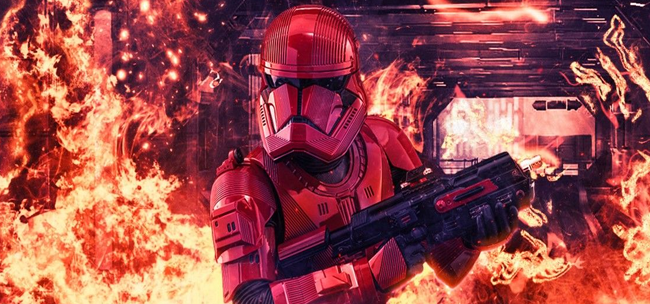
The Sith troopers’ right shoulder-mounted sensor telemetry pod emitted active signals programmed to bounce and return, providing accurate environmental data to feed back to a command center through encrypted telemetry. The right forearm gauntlet had a built-in data storage module with an access port, the armor’s articulated magnatomic plates permitted the troopers’ greater range in movement, and the anisotropic bands increased the surface area for radiating excess energy from impacts. The corrugated body glove that was worn under the quad-folded gammaplast armor had an internal atmosphere. The utility belt contained power cell ammunition as well as a detonite explosive charge.


